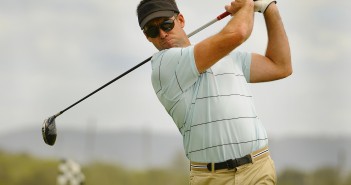For maximum power creation in the golf swing, with minimal negative stress on the body, the ground must be the first link in the kinetic chain of energy transfer.
Newton’s third law of motion tells us that using the legs to drive forcefully into the ground results in the ground pushing back up into the golfer’s body with an equal magnitude of force. The force the ground transfers into the golfer is known as the ground reaction force (GRF). GRF is then transferred up the kinetic chain, first through the legs and into the pelvis, then up into the golfer’s core, shoulder complex, arms, and, finally, the golf club and ball.
Transferring this energy up the kinetic chain from the ground to the ball with the most efficiency is what allows you to create the most power (club head speed) your body will allow.
Imagine a small ball on the end of a string, which is attached to the end of a pencil, and you’re holding the other end of the pencil in your fingers. When you swing the ball around the pencil, if you want to swing the ball as fast as you possibly can, then your fingers need to make a very small, tightly centred, rotational movement, constantly feeling for and pulling against the weight of the ball. You use centripetal force to accelerate the ball, pulling it towards the centre, not linear force pushing on the ball. Though over simplified, this is a great analogy for the use of GRF in the golf swing, the ball being the club head, and although the golf club isn’t a string, it behaves much as the string does when the ball is rotating fast.
The golf swing has more in common with swinging our ball on a string than it does with swinging a heavy hammer or even a baseball bat. In baseball, the ball is moving towards you at approaching 100mph, its effective weight is enormous, and to hit it out of the park you need to hit it hard, with your weight behind the bat to stabilise it, thus requiring a wider stance. In golf, the ball isn’t moving, and it weighs just a few ounces. To hit a golf ball 300+ yards you need to hit it with a club head that is moving very fast, and putting your weight behind the shot won’t help.
The best way generate club head speed is not by pushing the club, but by imparting angular momentum through the rotation of your body, and then pulling against the weight of the club through impact, just as you do with the ball on the string. You use centripetal force to accelerate the club head, pulling it towards the centre of your rotation, and not linear force pushing on the grip. Just like the ball on the string, it is a tightly centred rotational motion that generates maximum club head speed.
This pull towards the centre of your rotation is generated by your legs pushing against the ground. When you watch (right handed) elite golfers trying to generate maximum power, they squat a little into their right glute at the top of the backswing, transfer their weight into the left glute during the transition, and then thrust the left leg into the ground through impact.
This squat move is often criticised by “old school” golf pundits, because it involves lowering your head at the start of the downswing (though you still maintain your spine angle, it’s the legs that “dip”), but almost every top golfer does it in the modern swing. It’s a very powerful move, when done correctly, as we’ll teach you in the Swing like a Champion system.
If you have any questions or comments about this or other articles on Golf Loopy, please send us an email.
You May Also Like…
Overview of a Great Golf Swing, which summarises the correct movements in a great golf swing, and describes how the core muscles help to power and stabilise the golf swing.
An overview of the golf swing kinematic sequence, including a detailed analysis of the Downswing phase in Golf Swing Sequence and Timing.
Golf Swing Sequence and Timing – Common Faults, which gives a comparison of the kinematic sequence for typical amateurs and Tour Pros, showing the common flaws that may plague your own golf swing.
Golf Lag and the Compound Pendulum, which describes how you can use physics to generate more speed, accuracy and consistency in your golf swing, with less effort and less strain on your body.
Why is Having the Shoulders “Connected” So Important? Which explains how the shoulders enable the power of the big muscles in your legs and core to be transferred to the golf club.
Golf Anatomy and Kinesiology, a collection of articles describing the roles of the muscles involved in the golf swing.
Core muscles, which describes the muscles that run the length of your trunk and torso.
Gluteal muscles, which describes the “glutes” — the three muscles that make up the buttocks, and how they power the golf swing kinetic chain through the core.
Kinetic Chain, which describes how the different parts of your body act to transfer energy from the ground to the golf ball.




